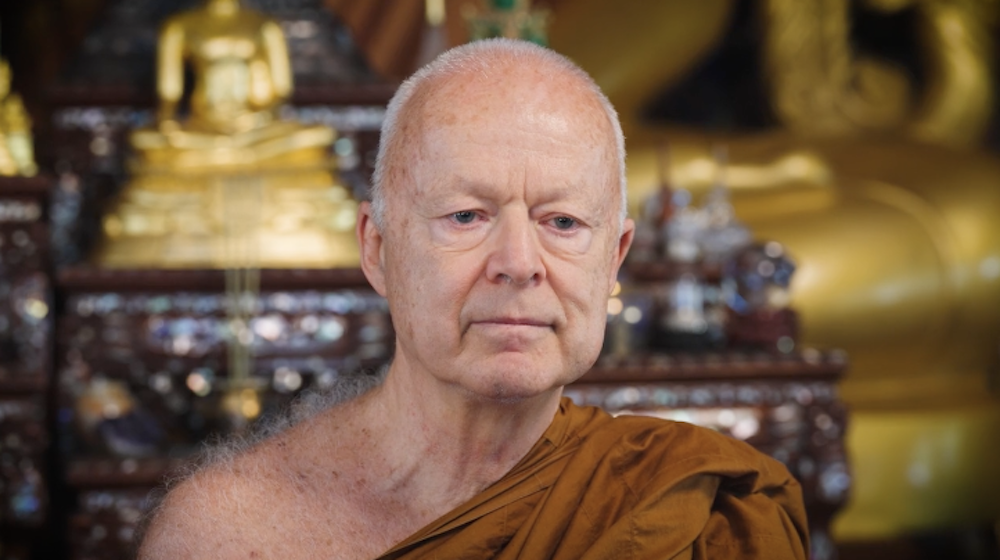The Buddha’s Alternative to Acting out in Anger
Thanissaro Bhikkhu explains how to use the three fabrications—bodily, verbal, and mental—to understand and skillfully work with anger. The post The Buddha’s Alternative to Acting out in Anger appeared first on Tricycle: The Buddhist Review.

Thanissaro Bhikkhu explains how to use the three fabrications—bodily, verbal, and mental—to understand and skillfully work with anger.
By Thanissaro Bhikkhu Mar 20, 2023 Thanissaro Bhikkhu
Thanissaro BhikkhuOne of the Buddha’s most important insights was that what we experience in the present moment is not entirely caused by the past. Some of our experiences do come from past karma. But the important part is how we shape the raw material coming in from the past through our present intentions. The Buddha calls this process of shaping sankhara, or fabrication.
There are three kinds of sankhara. There is a bodily fabrication, which is the in- and out-breath. There is a verbal fabrication, which the texts call directed thought and evaluation. It’s basically how you talk to yourself, the questions you ask, and the judgments you pass on things. And then there’s a mental fabrication, which is felt as perceptions. Feelings here are not emotions; they are more feeling tones: a tone of pleasure, a tone of pain, or a tone of neither pleasure nor pain. Perceptions are the labels you apply to things. If you were to compare verbal fabrication with perceptions, verbal fabrication would be full sentences or questions; perceptions are individual words or images.
The way you identify things is through these three processes. We shape the raw material coming in from the past and turn it into our experience of the present moment. The problem is that we tend to do this in ignorance. This is why instead of creating the happiness that we want, we end up creating stress and suffering. The Buddha tells us to do these processes with knowledge, and they can turn into the path to the end of suffering.
Anger is a case in point. All three of these fabrications go into creating a sense of anger. Say that you have witnessed a situation that you don’t like, one you’d like to see changed, and you’re upset about it. The way you breathe is going to aggravate the anger. You tend to breathe in a tight, tense way. You can talk to yourself, both about the situation and about anger itself, in ways that aggravate it. You can focus more and more on how horrible the situation is and how quickly it needs to be changed. You can also talk to yourself about anger and think your anger is justified. It’s your way of showing that you can influence the world and that you can get things done through your anger.
And then there are the perceptions and feelings. The feelings, in this case, would be feelings of discomfort because the breath is uncomfortable and the way you’re talking to yourself is uncomfortable. And then there are the perceptions: your perceptions about the situation—the person who has done or said something horrible is either a monster or a pig—and your perception of anger as being your way of showing your power in the world and being a warrior in the world. Now, the problem is many times we act on our anger thinking that we’re doing something skillful, something that’s to our benefit or the benefit of those we love. We find out later that this is not the case and that we’ve actually created trouble for ourselves. This is where the Buddha says we have to bring knowledge to these processes.
First, we have to understand the anger in terms of these types of fabrication so we can take it apart and replace it with better fabrications. The techniques you learn with breath meditation help you right here so that you can reflect on what you’re doing as you focus on the breath. Of course, you have bodily fabrication in the breath itself. You have verbal fabrication in the questions you’re asking about how to breathe comfortably, how to let those comfortable breath sensations spread through the body, and how to keep the mind with the breath. Then there are mental fabrications, your perceptions you have of the breath as being a whole body process, the feelings of ease that you can create by the way you breathe. You have hands-on experience in these types of fabrication. You see how they can be used to create a sense of well-being right here, right now. And then you can bring that knowledge to the rest of your life.
The techniques we learn on the meditation cushion are not meant just for the cushion. After all, we’re not creating suffering for ourselves only on the cushion. We go through life. So we’re going to take those techniques and use them on a day-to-day basis.
The first thing to take is verbal fabrication. As you talk to yourself, remind yourself of all the stupid things you’ve done under the power of anger. It might be good to step back from the anger. See what you can do to take it apart. And then you focus on verbal fabrication. How are you breathing? Can you breathe in a way that calms you down? Think of the breath going all the way down to the feet, nourishing every part of the body. That sense that you have to get it out of your system begins to dissolve away. For the most part, we think that we have only two choices: either we get it out of our system by acting on the anger or we bottle it up. Neither way is helpful. If we bottle anger up, it becomes a thing that goes underground and shows its tentacles someplace else. If we act on anger, we end up creating trouble for ourselves.
Here the Buddha is giving you an alternative to that sense of tightness. You have a body, and you can breathe through it. Dissolve it with good breath sensations. This may take time because that first burst of anger probably released some hormones into your bloodstream, and they’re still having their effect. And sometimes we read those signs as signs that we still are angry even though the actual anger may have passed. We stir it up again. Just remind yourself that it may take some time, but you can breathe in a way that calms down the sense of tension, tightness, and irritability in the body. This process allows you to look at the anger more objectively, more calmly, and to look at the situation more calmly and see what needs to be done.
This is where you bring in verbal fabrication. Ask yourself: Is that person or that situation as bad as you think it is? Is it as unbearable as you think it is? Here the Buddha gives you some ways of talking to yourself when someone has said something unpleasant or hurtful. He recommends two ways of depersonalizing the issue. One is just to tell yourself that the unpleasant sound has made contact with the ear. It’s there because of the contact, and when the contact goes, that’s the end of that unpleasant sound. How many times have you thought that when someone curses you or when someone says something harsh and vile? It’s not the first thing that occurs to you. But it’s useful because you realize that from that point on, once the contract has ended, the fact that it’s reverberating around in your mind is based on what you’re doing now. The action of the other person is over and done with. Do you want to keep on stabbing yourself with those words? It’s your choice.
The second way of depersonalizing words is to remind yourself that human speech has all kinds. The nature of human speech is that there’s kind speech and unkind speech, true speech and untrue speech, where it’s said with an attitude that means well to you and where it’s said with an attitude that doesn’t mean well to you. This is the nature of human speech everywhere. The fact that you’re subjected to that kind of unkind or untrue or ill-intentioned speech is nothing out of the ordinary. All too often we find a situation horrible or totally unbearable. Everything is so extraordinary that we have extraordinary rights to react in a way. It’s not all that skillful. But when you realize this is the nature of the human world, this is the nature of human speech, you back off. You realize that the action was not extraordinary, so your rights are not extraordinary either.
These are some ways of helping you pull yourself out of the unskillful verbal fabrication that finds the situation unbearable.
⧫
Learn more about the three kinds of sankhara in Thanissaro Bhikkhu’s Dharma Talk, “Skillful Approaches to Anger”, from which this excerpt was adapted.
![]()
Thank you for subscribing to Tricycle! As a nonprofit, we depend on readers like you to keep Buddhist teachings and practices widely available.
This article is only for Subscribers!
Subscribe now to read this article and get immediate access to everything else.
Already a subscriber? Log in.

 Astrong
Astrong 
































